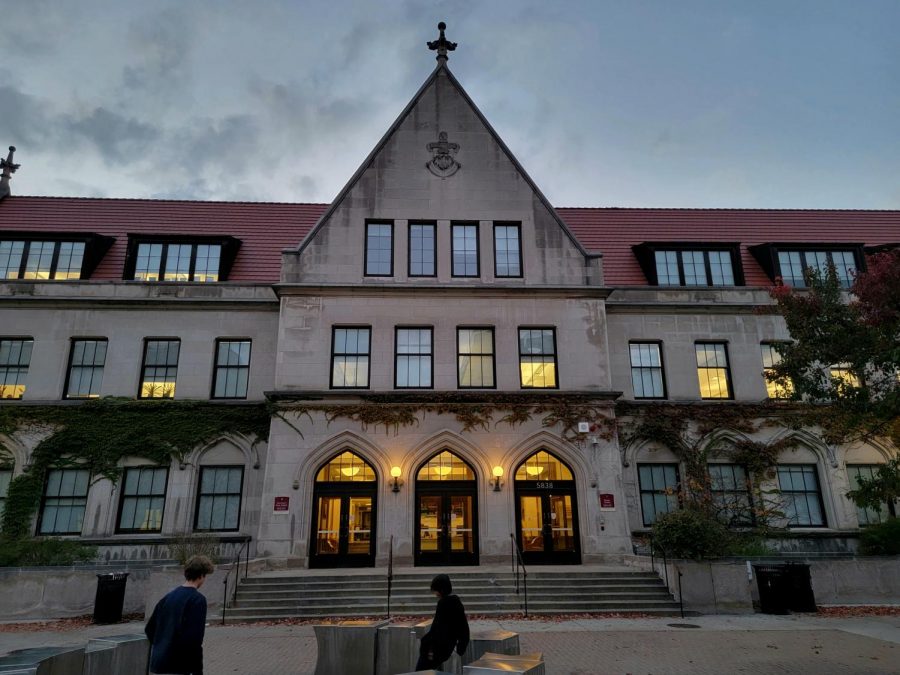Green initiatives to help reduce Lab emissions
November 12, 2021
TURNING OFF THE LIGHTS. The Laboratory Schools’ lights stay on from 5:30 a.m. to 1:30 a.m. the next day, according to Lab’s director of operations Joe Wachowski. This is to accomodate faculty access hours and allow custodial workers to finish cleaning.
Imagine the yearly greenhouse gas emissions of 585 average American households, enough for a small town. These emissions total 4,390 metric tons — equivalent to the annual greenhouse gas emissions for the Laboratory Schools historic campus, according to the most recent data from the City of Chicago.
Although Lab has several initiatives to reduce emissions, and incorporates environmental thinking into decision making, the school lacks a long-term strategic vision for emission reduction.
One unique challenge, according to Joe Wachowski, Lab’s director of operations, is reducing the electricity used for lights, which composes a significant part of overall emissions.
“A lot of lights at school are on from 5:30 a.m. to 1 a.m. the next day,” Mr. Wachowski said. “The problem is that there’s always something going on after school. That means custodial staff have to stay to clean up, and they need the lights on.”
Even though Earl Shapiro Hall, opened in 2014, and Gordon Parks Arts Hall, opened in 2015, are Lab’s newest buildings, they also use the most electricity because they have more lights, according to Mr. Wachowski, and the lights are an older luminescent style. When the buildings were designed and constructed, LED lights, which are estimated to produce half the emissions of the luminescent ones used, were too expensive for mass use. As the bulbs are more widely produced their prices decrease, the University of Chicago now estimates it can save 5% in total energy costs by replacing all campus luminescent bulbs with LEDs.
UChicago contractors recently completed a lighting audit of Sunny Gymnasium, a first step to replace the luminescent bulbs with LEDs. The initiative to replace all old bulbs with efficient LEDs is part of UChicago’s sustainability plan to cut emissions by half by 2030.
Although institutional action to curb climate change is of paramount importance, Tony Del Campo, a middle school Earth sciences teacher, believes individuals can still have a powerful effect. He recommends students think critically about how their routine actions contribute to climate change.
“If you’re driving, then you should think about the gasses that you’re putting in the atmosphere, and decide whether it’s worth it. If you’re thinking of buying something new, ask yourself if you really need it,” Mr. Del Campo said. “Refusal is one of the most powerful tools at reducing emissions.”
Brian Hewlett, executive director of finance and operations, believes this framework of incorporating critical environmental thinking to routine tasks also works at a school level.
“We try to think of environmental impact in our day-to-day decisions, whether it’s about reusing an old cabinet, or setting up a sustainable storm water drainage system for Jackman Field,” Mr. Hewlett said, adding that sustainability is always an important factor.
One example of day-to-day environmental impact is Café Lab contractor Quest Food Management’s EarthAware program, which works to minimize Lab’s carbon footprint by purchasing from local vendors and farmers. All leftover food is also composted daily in partnership with Healthy Soil Compost, a West Side waste management service.
Mr. Del Campo is pleased by the initiatives but hopes the school does more to come up with a long-term strategic vision for reducing emissions. He wants the school to write a climate change statement alongside the mission and diversity statements.
“A mission statement would signal Lab’s commitment to addressing climate change, and I think it would help justify certain things to students, like having a no-meat day at the cafeteria,” Mr. Del Campo said, referencing the mammoth greenhouse gas footprint of the meat industry.
He said steps like the statement and hiring a director of sustainability would help with accountability.
Mr. Wachowski acknowledged that he can’t think of a long-term set of goals in place to cut emissions at Lab, nor an administrator who works on improving sustainability.
“The way sustainability works at Lab is more volunteer-based. Some years there’s a lot of excitement from faculty and students and a lot of cool efforts happen, and other years there’s a lot less,” Mr. Wachowski said. “Otherwise, our goals come from UChicago’s sustainability plan.”
Regardless, both Mr. Del Campo and Mr. Wachowski believe that a more sustainable Lab will take the combined efforts of individuals as well as support from the university.
“I’m very hopeful about the future of the school and the world when it comes to climate change,” Mr. Del Campo said. “Even 10 years ago, a lot of the questions I got from students would be skeptical about whether climate change exists. Now, students know it does and are looking for solutions. Young people are demanding a more sustainable future from the people around them and their political leaders.”
